
Guests
- Tatsuya Yoshiokaco-founder and director of Peace Boat. Since the 1980s, he has been organizing voyages to educate people about Japan’s invasions of Asian countries and to promote reconciliation.
In 1983, a group of Japanese students formed Peace Boat as a response to government censorship of history books regarding Japan’s past military aggression in the Asia Pacific. They chartered a ship to visit neighboring countries and build people-to-people exchanges. Three decades later, Peace Boat now operates a chartered passenger ship that travels the world on peace voyages. The group also organizes against the use of nuclear weapons, nuclear power and other forms of militarism. After the 2011 earthquake and tsunami, the Peace Boat’s Disaster Relief Volunteer Center organized thousands of volunteers to help in the relief and rebuilding effort. Peace Boat founder Tatsuya Yoshioka joins us in Tokyo.
Transcript
AMY GOODMAN: We’re broadcasting from Tokyo, Japan. We turn now to the founder of one of the largest peace groups in Japan. In 1983, Tatsuya Yoshioka and a group of other students formed Peace Boat as a response to government censorship of history books regarding Japan’s past military aggression in the Asia Pacific. They chartered a ship to visit neighboring countries and build people-to-people exchanges. Three decades later, Peace Boat now operates a chartered passenger ship that travels the world on peace voyages. The group also organizes against the use of nuclear weapons, nuclear power and other forms of militarism. After the 2011 earthquake and tsunami, the Peace Boat’s Disaster Relief Volunteer Center organized thousands of volunteers to help in the relief and rebuilding effort. Peace Boat founder Tatsuya Yoshioka joins us here in Tokyo.
We welcome you to Democracy Now!
TATSUYA YOSHIOKA: Thank you very much.
AMY GOODMAN: Tell us more just what Peace Boat is, both the boat—
TATSUYA YOSHIOKA: Yeah.
AMY GOODMAN: —and what you’re are trying to do to ensure that the history of Japan is told accurately in the schools here?
TATSUYA YOSHIOKA: Yeah, I think that the Peace Boat’s quite unique point is actually we are organizing the cruise voyage by the passenger ship, quite big passenger ship, like this one—this is the ship. Anyway, that’s—in this scale, try to bring the young people, especially, and to learn that past history through their own experience there. So, I think that’s—it is very difficult, especially for young people, to study about or to understand that, the reality of the history. They’re only just learning in a classroom or in a university. So, I think, for me, this is a kind of the very live, the active way of learning of the past, the issue and past history. So, in that base of the building the peace, that is my strong belief, especially East Asia.
AMY GOODMAN: Talk about what you’re doing onshore here in Japan, what you’re doing in the schools.
TATSUYA YOSHIOKA: Yeah, I think that’s one of the biggest problem, is the government and also the teachers. They’re not so—they’re quite negative, or they’re passive, to tell the truth of the past history, especially about Japanese invasion or aggression in the past. But my point of view, of course, that if we really would like to make a friendship with the neighborhood, with the Koreans and the Chinese, of course we have to understand that, what’s happened in the past, right?
AMY GOODMAN: I think, for a U.S. audience, an American audience, or an audience outside Japan, outside of Asia, they may not be familiar with the history that you’re talking about. If you could summarize it for us, what you’re most concerned gets told?
TATSUYA YOSHIOKA: Yeah. I think that is one of the most important points. We have to face to the truth, especially what we have done in committed war crime or such ugly things. And otherwise, if we try to avoid to face to that truth in the past, and especially that terrible issue, so—and nobody respect us, whatever we are saying about peace, because I think the peace is coming from that very strong will not to repeat again.
AMY GOODMAN: Talk about the massacre of Nanking, which at the time, in 1937, was the Chinese capital.
TATSUYA YOSHIOKA: Yeah. So, and that is—maybe that is—quite a lot of people know, that—especially historians, that is, hundreds of the Chinese people were killed by the Japanese soldiers at that time, and enormous amount of the ladies raped, and so on. And this issue is, for Chinese people, is a very serious and very hard memory. So—
AMY GOODMAN: What was happening in 1937? How did this take place?
TATSUYA YOSHIOKA: Oh, yeah, that’s a—the Japanese troops occupied Nanking at that time, the Chinese capital, just—yeah. And the Japanese troops started to really—let’s say, everything, what they can do there. So, and victims, as I said to you, that several hundred thousand of the people, they killed. So, but now, the point is, in the Japanese society, including the government, tried to start to delete this history from the history textbook or in the public discussion. So, I think I’m really worried about that.
AMY GOODMAN: So, talking about the number of people who were killed in the massacre of Nanking, we’re talking about the range of 200,000 to 300,000—
TATSUYA YOSHIOKA: Yeah.
AMY GOODMAN: —Chinese people?
TATSUYA YOSHIOKA: Yeah. That is mainly Chinese people saying, but there’s a lot of opinion. But a quite reasonable size, the historians’ opinion, is between 100,000 to 200,000. I think that is something like that. But, for me, the number is—the human life is not a number. And I think that even if there’s 300,000 or even 50,000, that is a terrible past truth, yeah.
AMY GOODMAN: And is the narrative, what happened there, as it’s told in Japan and taught in schools—has it changed over time?
TATSUYA YOSHIOKA: Yeah, quite changed, that 30 years ago started, something like in school—not school, in so-called commentators or, you know, the critics people, these people start to say maybe that was not happened, in Japan. And that’s the beginning of the 1980s. But now, there are quite a lot of people that try to avoid saying “massacre” or such kind of strong word. They are saying something, “Nanking incident.” Yeah, that’s a—these 30 years is really the history of the—to try start to delete or to make vague our history. That is my feeling. But that is more and more the provoke, among the Chinese people, against the Japanese pacifism.
AMY GOODMAN: How does this all fit in with the current prime minister, the most conservative since World War II, Prime Minister Abe—
TATSUYA YOSHIOKA: Yeah.
AMY GOODMAN: —visiting the Yasukuni Shrine?
TATSUYA YOSHIOKA: Yes.
AMY GOODMAN: Explain the significance of that visit and the shrine.
TATSUYA YOSHIOKA: I think that is a really—even as a Japanese—very unacceptable action by himself. I think maybe the—
AMY GOODMAN: Who’s buried there?
TATSUYA YOSHIOKA: That is including the seven war criminal, who has judged by the Tokyo trial, the—
AMY GOODMAN: These are the Class A war criminals.
TATSUYA YOSHIOKA: A Class.
AMY GOODMAN: A Class.
TATSUYA YOSHIOKA: A Class, yeah. So, and it means that they are leading, and that they committed the war crime during World War II. And that there as a god—maybe that is a system of the Japanese shrine system: As a god, they are there. And—
AMY GOODMAN: How did Prime Minister Abe explain this visit, one that recent prime ministers had not made?
TATSUYA YOSHIOKA: Yeah, that is the most tricky point. He’s saying that just he would like to pray for the victims of the Japanese soldier. But they are not—these seven especially—they are not a victim. They forced to the Japanese soldiers to go there, in China and in many Asian countries, and kill other people. And they also, the Japanese soldiers, also die. So, I think this is a very important point, is the Yasukuni Shrine is including the leader of the war, the aggression, and also victim of the Japanese soldiers.
AMY GOODMAN: Can you talk about Article 9 of the Constitution—
TATSUYA YOSHIOKA: Yeah.
AMY GOODMAN: —the one that says that Japan should not have an army?
TATSUYA YOSHIOKA: Yeah.
AMY GOODMAN: The U.S. ensured that that was in the Japanese Constitution after World War II.
TATSUYA YOSHIOKA: Yeah.
AMY GOODMAN: Yet now the U.S. is pushing for it to be removed—
TATSUYA YOSHIOKA: Yeah.
AMY GOODMAN: —as is the government, the current government. Explain the significance of Article 9 and what Peace Boat is pushing for.
TATSUYA YOSHIOKA: OK. I think that, as Peace Boat, we organized a global conference for the Article 9. The reason why is that this peace constitution is a very important piece in the stability in—
AMY GOODMAN: You call it the “peace constitution.”
TATSUYA YOSHIOKA: Yeah, we are calling it peace constitution, but especially Article 9 is in that peace constitution, is the most important part to renounce war and also military. And this is a very historical irony. And in the beginning, the United States, as a ruler over Japan, they completely—they forced that Japan is demilitarized. But after that, Cold War started. So, your government, they start to force us to have the military, even that peace constitution—
AMY GOODMAN: So, the very government that demanded Article 9—
TATSUYA YOSHIOKA: Yeah.
AMY GOODMAN: —no army, then is pushing for Article 9’s removal.
TATSUYA YOSHIOKA: Exactly. Especially, there’s a Korean War, at that time, is a turning point. And after that, continuously, the U.S. government is pushing Japan to more and more militarize, and as one of the brother—the military of the U.S. military.
AMY GOODMAN: Will Article 9 be removed?
TATSUYA YOSHIOKA: Yeah. So, Article 9 is—that is one of the very—that annoy, the existence, for the U.S. policy, I think, even now, and that’s why this is a very strong struggle for the Japanese organization, the peace organization, to try to protect this one to really keep the peace and stability in this region. But I would like to add one thing. That is, Article 9 is not only that. I think this is a kind of very strong peace message from the experience of terrible war. And 200,000—more than 200,000 people died in the Asian Pacific through the war, so—and I think that the soul of these peoples is becoming the Article 9.
AMY GOODMAN: Tatsuya, finally, talk about nuclear power.
TATSUYA YOSHIOKA: Yeah.
AMY GOODMAN: And just this week, as we are here, the government has announced they’re going to push for more plants, nuclear power plants. Yet clearly the Japanese population is increasingly opposed to nuclear power—
TATSUYA YOSHIOKA: Yeah.
AMY GOODMAN: —with Fukushima and the meltdowns at the plant.
TATSUYA YOSHIOKA: Yeah.
AMY GOODMAN: Talk about what Peace Boat did during the aftermath of Fukushima and your feelings about nuclear power.
TATSUYA YOSHIOKA: Yeah, we organized the very—the big scale of the nuclear-power-free global conference the year 2012. But the reason why is I think that Japan experienced Hiroshima and then Nagasaki, as you know, and now we have the Fukushima. So, and if Japan start again to promote nuclear power plants, this is a terrible message to the world, that something like even the—who suffered so much, but we still insist about the nuclear power plants, I think that is a completely—we make some kind of the wrong message to the world. So, and I really insist that is a nuclear weapon experience—Hiroshima, Nagasaki—and we have the Fukushima experience, and still victim is suffering continuously, and we are leaking the contaminated water to the Pacific Ocean. So, what we have to do is, I think, very clear. And also, I would like to add, this is quite related with the right-wing Japanese people, would like to nuclear weapon armed, because the nuclear power plants, they continuously produce the plutonium, and this is the material for the nuclear weapon. I think that already some right-wing politicians start to discuss openly about the necessity of the nuclear arm for Japanese. And we really, really cannot accept that, as a country who experienced Hiroshima and Nagasaki.
AMY GOODMAN: It’s quite remarkable when you look at recent Japanese history, the bookending, the only country to have two atomic bombs dropped on it, by the United States, and then, now, close to 70 years later, you have Japan—what, 30 percent of the electricity, of the energy, comes from nuclear power, with a push to 50 percent by 2030, but then Fukushima happens.
TATSUYA YOSHIOKA: Exactly.
AMY GOODMAN: So, how are people organizing?
TATSUYA YOSHIOKA: I think that’s a—I really hope—still, Japanese people, more than half, that are willing to denuclear-power the society, but that, unfortunately, the government is completely taking the other direction. So, and I think that the only way is we really have to promote with peoples the denuclear-power-plant society.
AMY GOODMAN: Well, Tatsuya Yoshioka, I want to thank you for being with us.
TATSUYA YOSHIOKA: Oh, you’re welcome.
AMY GOODMAN: Co-founder and director of Peace Boat. Since the 1980s, he has been organizing voyages to educate people about Japan’s invasions of Asian countries and to promote reconciliation as well as peace. Peace Boat was critical also after the earthquake and tsunami of 2011. This is Democracy Now! When we come back, we look at the TPP, the Japanese perspective on that, and also may end up going to the U.S. Congress to find out what’s happening there today with a hearing. Stay with us.

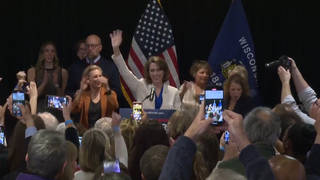
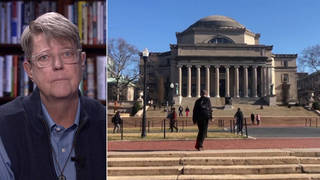
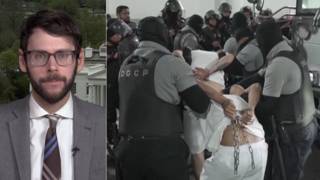
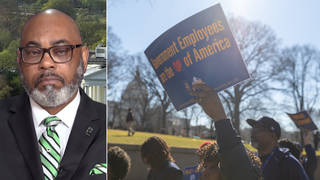





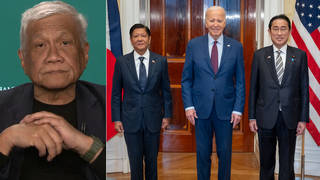
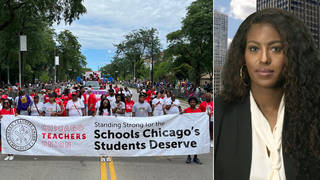
Media Options